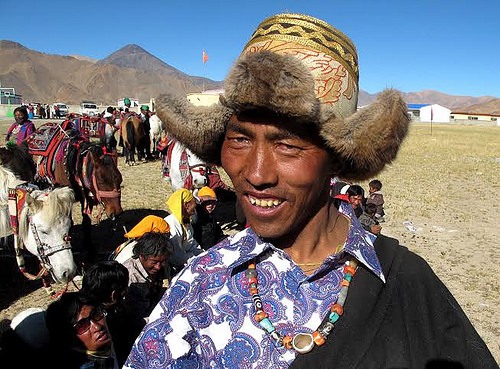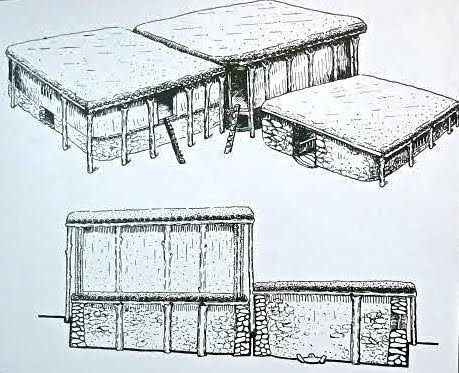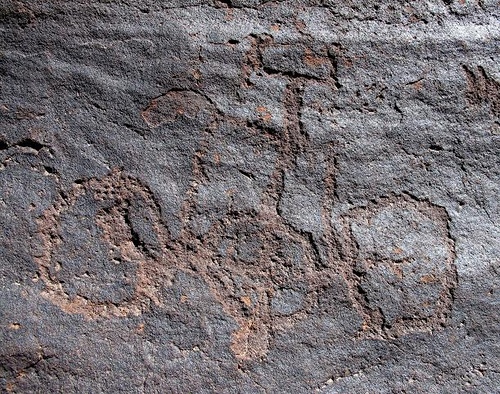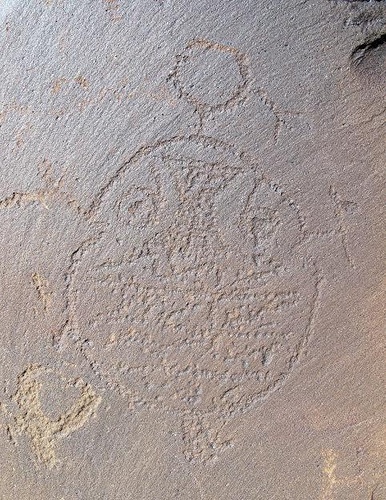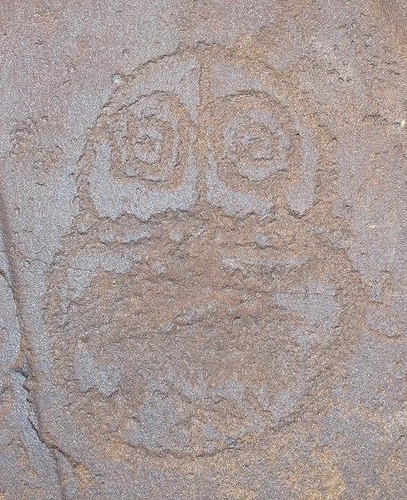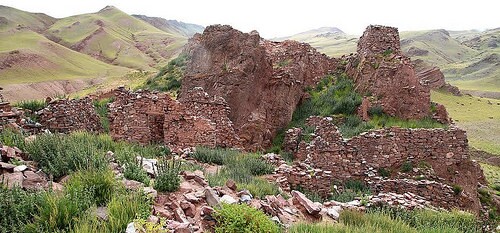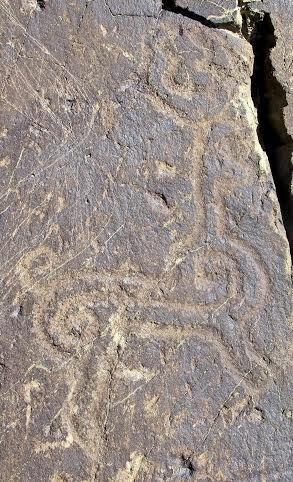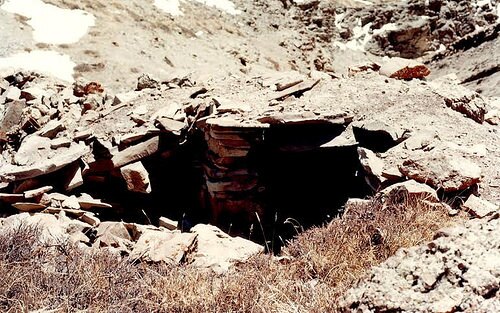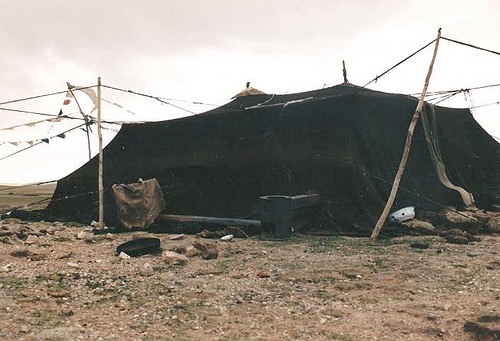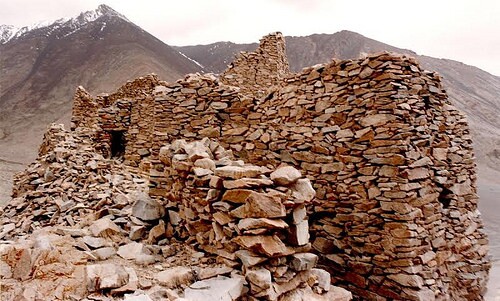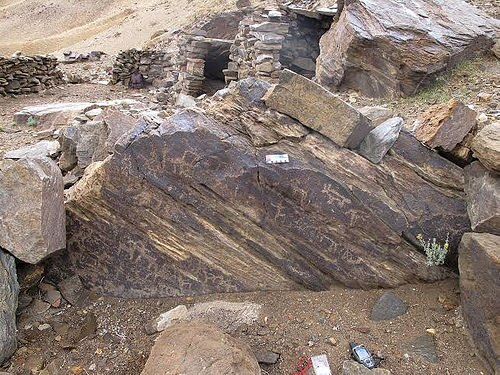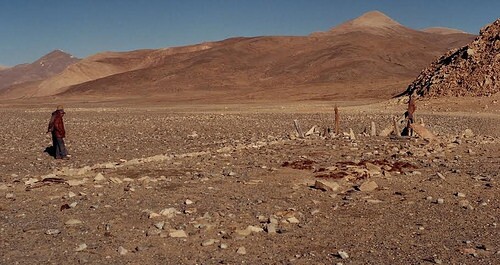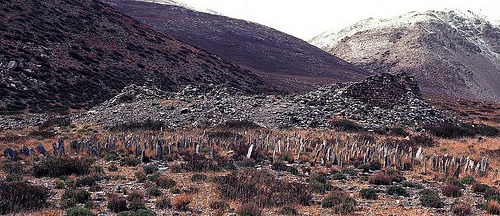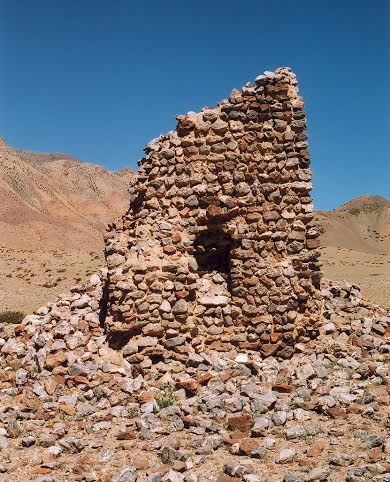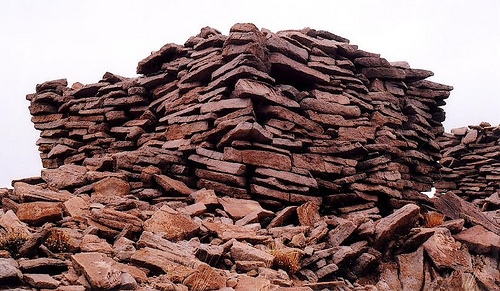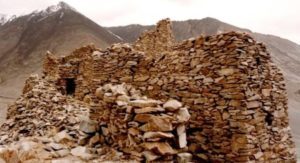
The Tibetan Plateau is the highest inhabited place on earth. Situated in the heart of Asia, this vast expanse, larger than the states of Alaska and Texas combined, averages 14,000 feet in elevation. Yet despite its great altitude, humans have been living in Tibet since remote antiquity. Not content with a mere subsistence livelihood, ancient Tibetans founded a civilization of epic proportions.
My introduction to Tibet began more than three decades ago when, as a youth, I began exploring the Plateau. As a young traveler, I was attracted to the wilderness and the isolated groups of people living in their traditional manner. For months at a time, I wandered across the Tibetan Plateau on foot and by hitchhiking, eating whatever there was and sleeping wherever I could find a decent place to lay down my bedroll.
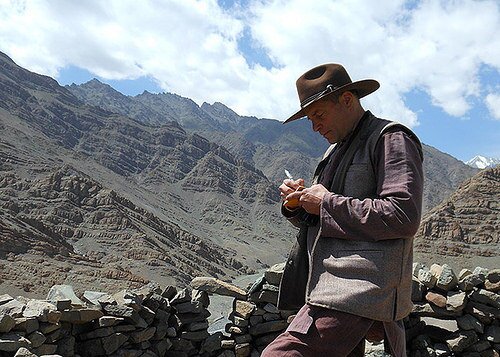 I began my explorations in Ladakh and Zanzkar, regions perched on the western edge of the Tibetan Plateau. In the spring of 1984 I managed to enter northeastern Tibet, a restricted area known as Amdo. After the opening of the so-called Tibet Autonomous Region (TAR) to international tourism, I then moved on to the central and western portions of Tibet, spending 15 months there on my first sojourn. At first, I had no particular aim to satisfy. My objectives were to simply see novel places, meet new people and learn as much as I could about the culture and history of Tibet.
I began my explorations in Ladakh and Zanzkar, regions perched on the western edge of the Tibetan Plateau. In the spring of 1984 I managed to enter northeastern Tibet, a restricted area known as Amdo. After the opening of the so-called Tibet Autonomous Region (TAR) to international tourism, I then moved on to the central and western portions of Tibet, spending 15 months there on my first sojourn. At first, I had no particular aim to satisfy. My objectives were to simply see novel places, meet new people and learn as much as I could about the culture and history of Tibet.
My travels took a scientific turn in the early 1990s when, while collecting geographic and ethnographic data in northern and western Tibet, I noticed strange formations of stones that obviously were not naturally occurring. Pursuing my research further, it dawned on me that these stone alignments and elevations were evidence of an unread chapter in Tibet’s past. They tell the tale of a remarkable people and way of life, vestiges of a civilization that existed before the Buddhist religion took hold in Tibet in the 7th and 8th centuries CE.
In time, I turned up a wide web of ruined fortresses and temples, necropolises and menhirs in the uppermost part of the Plateau—hard evidence for Tibet’s first civilization. In my first scholarly article published in the Tibet Journal in 1996, I sketched what I had found. Thirsting to know more, I returned to the field every year, searching the mountains, valleys and plains of the highest reaches of the Tibetan Plateau for a world largely forgotten and buried. Each new discovery shed additional light on what Tibet was like before the arrival of Buddhist monks and monasteries, yielding information on its technological and cultural capabilities and relationships with other ancient peoples.
My research has since shown that pre-Buddhist monuments and art are best preserved on the northern and western parts of the Plateau, the vast territory known as Upper Tibet or Tö. It is in this region of approximately 250,000 square miles that I have concentrated my efforts.
This is the story of that civilization’s first and most mysterious manifestation.
Northwest of Tibet’s capital Lhasa, beyond the lofty Transhimalayan ranges, is a vast tableland averaging more than 15,000 feet in elevation. This portion of Tibet is sparsely populated, with shepherds and a few farmers in the far west. Nonetheless, of all places, it was here in an icy land of interminable plains and high peaks that Tibetan civilization took root in its most dramatic form. This highland branch of civilization can now be associated with a kingdom, culture and language traditionally called Zhang Zhung (pronounced: Shang Shung) by the Tibetans………
In the Dawn
Thousands of years of a human presence preceded the development of high civilization in Tibet. To place this grand epoch in perspective, a summary of Tibet’s earlier prehistory is necessary. Studies of the Tibetan genome suggest that ancestors of today’s Tibetans established a foothold on the Plateau as much as 32,000 years ago. These early settlers not only inhabited the lower river valleys. They ventured out to occupy the vast highlands that blanket most of Tibet. Through genetic changes over millennia, Stone Age Tibetans acquired special physiological mechanisms to cope with hypoxia, the inadequate oxygenation of blood due to high altitude.
Flaked choppers and axes and other tools dating to the Old Stone Age have been found in sundry parts of Tibet. These types of tools have been interpreted in different ways by archaeologists, leading to divergent views on their age. Estimates range from 12,000 to 35,000 years ago. Follow-up studies to scientifically date tools by analyzing the contexts in which they occur are eagerly awaited.
The Neolithic
To date, Chinese and Tibetan archaeologists have documented more than two dozen New Stone Age [Neolithic} sites, stretching from one end of the Tibet Plateau to the other. These sites have been dated to 3500 to 5500 years ago. Some five millennia ago, villages with sizable stone and timber houses and a variety of crops appeared. At early Neolithic sites like Kharub, near the city of Chamdo in eastern Tibet, different species of millet were grown as staple crops. Millet was already being grown in the Yellow River valley of northwestern China at least two thousand years earlier, and it is probably from there that this crop spread to Kharub and other places in eastern Tibet. By the late Neolithic, barley and wheat were being cultivated in Central Tibet, a drier region than eastern Tibet. These crops were part of a suite of domesticates of west Asian origin that made their way across the continent to Tibet. Barley, wheat and peas reached western Tibet by circa 1500 BCE, probably through contact with Central Asian peoples who had already progressed to the Bronze Age stage of development.
The houses, cultivated fields, ceramics, textiles and polished stone tools of Neolithic Tibet set the backdrop for the technologically more advanced societies to follow. The progression from the Stone Age to the Metal Age seems to have progressed more slowly on the Tibetan Plateau than in some other regions of Eurasia. A large supply of wild herbivores like wild yak and antelope may have forestalled the transition from big game hunting to farming. Also, much of Tibet is only fit for pasturing livestock, a way of life at variance with agriculture. Thus, well-established economic and cultural traditions may have played a part in the ostensible prolonging of the Neolithic on the Plateau.
___________________________________________
Tibet (in red) within its geographic context. To its north and east, China, and to its south and west, India. Wikimedia Commons, TUBS
___________________________________________
Map of Upper Tibet and adjoining regions. Courtesy Brian Sebastian and John Vincent Bellezza.
____________________________________________
The Buddhist monastery of Stag Rock (Shawa Drak) in the eastern portion of Upper Tibet. On the summit of the formation are the ruins of early structures associated in Tibetan texts with the 8th century CE Bonpo religious master Nangsher Löpo.
_____________________________________________
Man at the horseraces in a village of northwestern Tibet.
_______________________________________________
Diagram of houses in the Neolithic village of Kharub, Tibet Museum, Lhasa.
_________________________________________________
Polished stone chisels from Kharub, Tibet Museum, Lhasa
________________________________________________
Bronze Age influences in Upper Tibet
Very little is known about how and when Upper Tibetans acquired Bronze Age cultural and technological traits typically associated with the wider Eurasian world. The search for these origins do not lead east or south, because Chinese and Indian influences from the Bronze Age are virtually absent in the archaeological record of Upper Tibet. In fact, China and India only began to exert a significant cultural influence on the central and western thirds of the Plateau with the rise of the Tibetan empire in the 7th century CE. To pinpoint Upper Tibet’s Metal Age origins, one must instead look north towards Central Asia.
However it precisely occurred, Tibetans picked up knowledge of Bronze Age chariots, a technological innovation closely connected to the Eurasian steppes. In the rock art of both northwestern and northeastern Tibet, chariots in a Central Asian mode of depiction are well represented. It is in Upper Tibet, the highest part of the Plateau, that chariot rock art is most numerous. To date, I have discovered more than two dozen chariot carvings. Some of the Upper Tibetan chariots are beautifully rendered with many technical details, including spoked wheels, box, pole, and draught horses. It is not clear if Upper Tibetans actually built chariots for practical or ritual use or if they were merely artistic depictions with symbolic functions. Either way, the chariot petroglyphs of the region demonstrate that Upper Tibetans were deeply influenced by Bronze Age technologies emanating from Central Asia. Chariot rock art also intimates that religious traditions and social customs associated with this technology had an effect on Upper Tibetans. Though it appears they simply aped Central Asian culture, the Upper Tibetans made it their own by positioning chariots among carvings of wild yaks, mounted archers with prominent headgear, swastikas and other subjects that epitomize their own culture and way of life. The direct dating of rock art is still not technologically feasible, but based on cross-cultural comparisons, chariot rock art in Upper Tibet is likely to have been made sometime between 1200 and 300 BCE.
___________________________________________
The author surveying chariot rock art on the Northern Plains (Changthang) of Upper Tibet.
____________________________________________
Highly detailed carving of a chariot in Upper Tibet. Note the charioteer standing in the square car and what appears to be a groom in front of the horses.
______________________________________________
Chariot petroglyph depicted with round car and without draught animals. This chariot is located at a rock art site in the central part of Upper Tibet.
_______________________________________________
Of all Bronze Age peoples, the Andronovo, a group of interrelated cultures spread over much of Central Asia, was best placed to have a major impact on Tibet. The Andronovo may have spoken Indo-Iranian languages and in their various cultural permutations were active from circa 2000 to 900 BCE. Among the many physical traces the Andronovo left behind is chariot rock art in styles reminiscent of Upper Tibet. This shared chariot art can possibly be attributed to a vanguard of Andronovo stockbreeders reaching the northwestern borders of the Plateau, initiating a period of intensive interaction with the Upper Tibetans. Even more likely is that ideas, methods and materials propagated by the Andronovo filtered southward into northwestern Tibet, brought there by a chain of localized groups. Either through direct contacts or a multicultural diffusion from Central Asia to the Plateau, the Andronovo appears to have injected Bronze Age technologies and ideologies into Upper Tibet, radically altering its culture.
The Bronze Age cultures responsible for the famous mummies of the Tarim Basin (in the Chinese province of Xinjiang) may also have had a bearing on Upper Tibet. In the Yanbulaq cemetery of Xinjiang around 76 graves were excavated by Chinese archaeologists and 29 complete skulls recovered; these date to circa 1300 to 500 BCE. Analysis of these skulls indicates that 21 of them are close in form to Tibetan populations. This evidence implies that there were long-standing ethnic links between Xinjiang and Tibet, regions separated from one another by a single mountain range, the Kunlun.
The earliest of the Bronze Age cultures of the Tarim Basin dates to circa 1800 BCE and appears to have historical links with another major cultural complex of Central Asia, the Afanasevo (circa 3500–2500 BCE). The Afanasevo culture, a Copper Age people, had a formative impact on the cultural and demographic complexion of Eurasia. Like the Andronovo culture, they appear have been versed in some equestrian arts. Through intermediary cultures, the Afanasevo culture may also also have had some influence on the development of Upper Tibet.
In Upper Tibet I also discovered ‘mascoids’, a kind of anthropomorphic rock art in emblematic form. This art only occurs in Ruthok, a district in northwestern Tibet. Among the earliest propagators of mascoid carvings was the Okunevo, a complex of related cultures centered in southern Siberia (circa 2000–1500 BCE). Through long-range migrations or more plausibly through transmission from one people to another, this art of the steppes and taiga seems to have been transferred to Upper Tibet. But unlike the chariots of Upper Tibet, which faithfully reproduced Central Asian examples, local inhabitants created their own genre of mascoid rock art. Rather than only a mask or face, some mascoids of Upper Tibet have tiny legs and arms attached to the head and wield spears, bows and other weapons. The head still dominates the composition, but in styles peculiar to Upper Tibet. As with chariot carvings, the Upper Tibetans stamped their cultural identity on mascoid rock art, making it their own.
________________________________________________
Mascoid carving with arms and legs and a complex array of elements inside the face, northwestern Tibet.
_______________________________________________
Mascoid with large eyes, northwestern Tibet.
________________________________________________
Interestingly, the mascoid rock art of Upper Tibet is most similar to that of Ladakh, a Plateau region situated immediately to the west. However, some types of mascoids in Ladakh are closer in style to those of Siberia. These stylistic affinities suggest that Ladakh acted as a conduit for the flow of cultural and artistic traits of the steppes and taiga to Upper Tibet. The rock art of Ladakh in general was strongly influenced by Central Asia, Siberia and Mongolia, betokening links between these regions beginning no later then the Bronze Age. Like the Tarim Basin, Ladakh appears to have been a major gateway for entry of Bronze Age customs and traditions onto the Tibetan Plateau.
The peoples of the northern steppes and forests who influenced the creation of chariot and mascoid rock art in Upper Tibet were probably also agents of other kinds of innovations on the Plateau, extending well beyond rock art. Chariots and mascoids embody seminal ideas, customs and traditions of a religious, social and political nature to which the Upper Tibetans were exposed. We can infer that a cultural revolution of sorts took place on the Plateau in the Bronze Age. The single most important technological introduction likely to be associated with chariot rock art is bronze metallurgy, for the two go hand in hand in Central Asia. The widespread production of copper alloy tools and weapons in Central Asia seems to have coincided with large-scale migrations of Indo-Iranian speakers eastwards around 2000 BCE, with climate change likely a big factor.
The cultivation of crops in the middle of Asia can be traced back to the Neolithic, endowing it with sedentary cultural patterns that evolved over millennia. Irrigation systems were highly evolved in southern parts of Bronze Age Central Asia, allowing for the spread of agriculture to many oases and glacially fed river valleys. The presence of agriculture and metallurgy in Central Asia must have acted as a springboard for the transfer of these formative technologies to Tibet. The planting of crops and the smelting of copper alloys can be correlated with crucial cultural changes, as users developed the vocabulary, mythology, rituals and ideologies to exploit and understand the implications of these material advances.
No settlements or tombs that conclusively exhibit Bronze Age features have been unearthed in Upper Tibet, and evidence elsewhere on the Plateau for the Bronze Age is weak. This could be because divisions between the Bronze Age and Iron Age characterizing Central Asian archaeology were weak or absent in Tibet. The result of a prolonged Neolithic in Tibet may be that smelting of copper and forging of iron arose there within the same timeframe. Parallels with ancient China might be relevant here, as there is still some ambiguity over the nature and duration of its Bronze Age.
The Iron Age and Zhang Zhung in Upper Tibet
Whether or not there was actually a discrete Bronze Age period in Upper Tibetan prehistory, ideas and materials connected to it permeated the cultural fabric of this part of the Plateau. This set the stage for a sedentary way of life and the citadel settlements that characterize the next phase of prehistory in Upper Tibet. It was during this period, as part of Tibet’s first great civilization, that the Zhang Zhung kingdom arose. These fortresses burst forth in the Iron Age (600–100 BCE) and continued to be constructed during Tibet’s Protohistoric period (100 BCE to 600 CE). They are especially numerous in far western Tibet where I have surveyed around 50 different sites.
The most distinctive large edifice in the Iron Age and Protohistoric period was the all-stone corbelled building. The stone elements in this type of architecture are extremely heavy, requiring specially designed walls to support them. Massively built walls supported roofs composed of stone corbels and bridging stones covered in stone sheathing. The corbelled arch was not employed in Upper Tibet; rather corbels and bridging stones overlap one another, progressively reducing the open space above them. The resulting gap is enclosed by thick slabs. These various roofing appurtenances are up to 8 feet in length.
______________________________________________
A portion of a large citadel mostly composed of all-stone corbelled structures. It was built on a summit overlooking a large lake in the middle of Upper Tibet. The structural components of these ruins suggest that the site was established in the Protohistoric period.
______________________________________________
The corbelling technique used in ancient Tibet was only effective in creating small rooms, typically less than 100 square feet. To construct large edifices (up to 200 feet in length) individual rooms or suites of rooms forming structurally self-sufficient units were joined together. These rambling structures often feature a meandering plan. The tallest edifices consisted of only two or three floors. To create towering structures, buildings were stacked on the ledges of steep rock formations.
The walls of the pre-Buddhist citadels and temples are usually windowless, creating dark, cavernous interior spaces. Entranceways are usually less than 4 feet in height, spurring folktales about these edifices being inhabited by an ancient race of dwarfs. Many structures are set deeply into the ground, creating a semi-subterranean aspect. This means that the all-stone corbelled buildings were not only easy to heat, but may have been associated with the pantheon of chthonic (underworld) spirits noted in Tibetan literature. The presence of shrines and deep recesses in the rear of some structures appear to have had ritualistic and mythological dimensions.
The citadels of Upper Tibet were planted on isolated peaks or ridge tops, conferring a defensive advantage. Evidently, protection was a major preoccupation for the builders, hinting at a militaristic social order. With the rise of nomadism in Central Asia, circa 1000 BCE, social tensions, mass migration and armed struggle was rife. This unsettled state of affairs seems to have affected Upper Tibet.
The impact of Iron Age Central Asia on Upper Tibet is also vividly recounted in its rock carvings. One of the most pervasive forms of rock art is the so-called ‘Eurasian animal style’, characterized by the sinuous depiction of predators, herbivores and birds using a variety of media. Rock art in the Eurasian animal style is commonplace in Central Asia, Siberia and Mongolia, as well as in northwestern Tibet and Ladakh. Dozens of lithe predators and prey in Upper Tibetan rock art document the penetration of Central Asian influences onto the Plateau. The complex of Iron Age cultural groups known as the Saka-Scythians was well placed to have brought the Eurasian animal style to Upper Tibet. The exact reasons are not yet known, but war, trade, diplomacy, proselytization or any number of other factors may have been involved in this artistic borrowing. If foreign invasion is indeed implicated, it would help to explain why ancient Upper Tibetans favored fortified settlements.
______________________________________________
A deer in the Upper Tibetan genre of the Eurasian animal style, northwestern Tibet.
_______________________________________________________________
The pre-Buddhist citadels of Upper Tibet stand over agricultural enclaves, most of which have been long abandoned due to a chronic shortage of water (Upper Tibet lies in the rain shadow of the highest mountain ranges in the world). Unlike Central Tibet, Ladakh or other places where prime sites have been redeveloped over the course of history, the pre-Buddhist residential architecture of Upper Tibet was often left untouched after its demise. Only the natural elements have conspired to efface these structures from the landscape. Unfortunately, the loss of glaciers and general climatic degradation continue to this day in Upper Tibet, exacerbated by global human-wrought changes.
Along with fortified settlements, all-stone corbelled temples and hermitages were built on out-of-the-way slopes. These concealed buildings appear to have been hubs of religious life in Iron Age and Protohistoric Upper Tibet. The citadels and temples constituted nuclei of elite social life in the pre-Buddhist period, the haunts of chieftains and high priests and their families and retainers. Regarding the humble or commoner sectors of ancient Upper Tibet society, the remains of villages with much smaller and more rudimentary residences have been detected at some agricultural sites; and most of the population likely dwelt in mobile shelters like the black yak hair tent. This spider-like structure was the most popular abode in this mainly pastoral region until 25 years ago.
______________________________________________
One of the all-stone corbelled structures at what appears to be a temple complex, western Tibet. Note how this structure is set deeply in the adjoining slope.
________________________________________________
A typical tent woven from black yak hair, Upper Tibet. Note the white strips flanking the entrance, a good luck attracting device. On the opposite side of the tent colorful prayer flags blow in the wind.
__________________________________________________
One of the most conspicuous qualities of elite residential architecture in pre-Buddhist Upper Tibet is its extremely high elevation. Many of the buildings tower over the surrounding plains and hills, standing at altitudes as much as 17,500 feet above sea-level, making them the highest permanent residences in world history. By contrast, in Buddhist-era Upper Tibet, monasteries and castles were situated at much lower elevations. Historical Tibetans had lost the taste for living at altitudes with which only they can cope. Cultural changes must have played a part, as archaic religious traditions placed much emphasis on the sky and heavenly bodies, whereas Buddhism focuses on mental processes. Also, in the time of Buddhism, Upper Tibetan culture shows signs of retrenchment, as areas of permanent occupation contracted ever further. After the collapse of the Tibetan empire in the mid-9th century CE, the Plateau never again rose up again as a center of international power.
The historical and cultural origins of the characteristic all-stone corbelled architecture in Upper Tibet are beclouded in uncertainty. Nevertheless, the picture is gradually becoming clearer. In 2001 I recovered a small round of wood deposited in an underground room, in what appears to have been a garrison connected to a large citadel. The sample was radiocarbon tested and yielded a calibrated date of circa 100 BCE to 100 CE. The chronological evidence indicates that this all-stone acropolis was already viable by the beginning of Upper Tibet’s Protohistoric period. In local culture this place is named after the territorial deity of Ruthok Gekhö. According to Tibetan religious literature, Gekhö was the chief god of the Zhang Zhung kingdom.
__________________________________________________
All-stone corbelled buildings at the Gekhö citadel, northwestern Tibet. The roofs of these structures are still partially intact
_____________________________________________________
At a site I documented in 2010, petroglyphs dating from the Protohistoric period and Early Historic period (600–1000 CE) cover stones once used in the foundations of all-stone corbelled buildings. These structures seem to have functioned as a hermitage or small village. The carvings were in all probability made as a kind of graffiti after the structures were abandoned. This suggests that the site had fallen into disrepair sometime before 600 CE.
____________________________________________________
Petroglyphs on the foundation of a residential structure. Note the remains of all-stone corbelled shelters in the background. This site was converted into corrals for sheep and goats.
_______________________________________________________
Organic materials collected in western Tibet from the foundations of small buildings with structural features recalling all-stone corbelled structures have been dated by the US archaeologist Mark Aldenderfer and Chinese colleagues to circa 500 BCE. This pushes the possible age of Upper Tibetan corbelled architecture back to the Iron Age. Evidence for Early Iron Age antiquity comes from a necropolis on the high plains of Upper Tibet at ‘Red House Talus-Covered’ (Khangmar Dzashak). This site boasts three above-ground mortuary temples that almost certainly had all-stone corbelled roofs. Foot bones I recovered from a grave at the site yielded calibrated radiocarbon dates clustered around 840 to 700 BCE. While it has not been proven that these tombs were built at the same time as the mortuary temples, this remains a distinct possibility.
Monuments of the Dead
Cemeteries and necropolises are dotted all over Upper Tibet, constituting some of the most important archaeological evidence for the pre-Buddhist epoch. I have documented several hundred of them over the last two decades. These burial and funerary ritual sites come in a variety of forms, heralding the cultural development of Tibet from the early first millennium BCE to the time of the Tibetan empire. Among the two most important funerary monuments are menhirs or pillars erected inside a stone enclosure and rows of pillars appended to a temple-tomb.
__________________________________________________
Pillars erected on the west side of a rectangular enclosure in the southern part of Upper Tibet.
____________________________________________________
One of three arrays of pillars at the site ‘Red House Talus-Covered’. The remains of a temple-tomb can be seen behind the standing stones. In the foreground, just out of view, is the tomb dated to the early first millennium BCE discussed in the text.
_____________________________________________________
One of the six complexes at Yul Khambu, the largest site of pillars and temple-tombs in Upper Tibet.
______________________________________________________
Tibetans call the pillars ‘long-stones’ or doring, the most conspicuous structural element at ancient sites with a funerary function. In conjunction with all-stone corbelled edifices, the highly distinctive pillar monuments circumscribe the majority of Upper Tibetan territory. They are not found in Central Tibet or in other adjoining areas; therefore, they serve as a kind of geographic marker of pre-Buddhist culture in Upper Tibet.
The exact function of the standing stones is still enigmatic. Accounts of ancient burial rites in Tibetan literature support their use in the protection of the souls of the deceased before they were ritually consigned to the celestial afterlife. The standing stones may also have been ritualized memorials for the dead, especially important during the annual cycle of apotropaic rites.
The ‘long-stones’ stand between 10 inches and 8 feet above the ground surface. The pillars erected inside a rectangular enclosure tend to be larger than those in multiple rows beside temple-tombs. Pillars are almost always situated on the west side of an enclosure, while the rows of pillars extend eastward from temple-tombs. Originally, there were between 200 and 2000 pillars in each of these concourses. These are among the largest aggregations of standing stones at ancient sites anywhere in the world.
Like the pillars, the temple-tombs range widely in size. The most impressive examples are up to 215 feet in length, making them among the largest prehistoric monuments in Tibet. Some of these heavily built mortuary temples are divided by walls into two or more chambers, which were presumably used to entomb high status members of ancient society. None of the stone roofs of the chambers have survived intact and human remains have not been discerned inside. Local treasure hunters over the centuries and the punishing climate of Upper Tibet have cleaned them out.
In both types of Upper Tibetan pillar monuments, structures tend to be oriented in the cardinal directions, indicating that topographical and astronomical alignments were probably part of their ritual use. The terrain in the east is almost always wide open, suggesting that the sunrise and the path of the sun played a role in ritual calculations associated with the funerary pillar monuments.
Samples from timbers extracted from the wall of a mausoleum with outlying structures comparable to the walled-in pillars have been radiocarbon dated to the 3rd to 5th centuries CE, an indication of the prehistoric antiquity of the pillar monuments. Petroglyphs and inscriptions engraved on standing stones as a kind of graffiti at a few sites seem to signify that their significance was diminished in the Early Historic period. Had they still been a major part of Upper Tibetan ceremonial life after 600 or 700 CE it is not likely that they would have been tampered with in this manner. The making of the carvings coincides with the introduction of Buddhism in Tibet, a religion with very different concepts about death and corpse disposal. Politics may also have been involved. The rulers of the Tibetan empire were based in Central Tibet, a region without a tradition of funerary pillar monuments.
__________________________________________________
Mausoleum predating the 6th century CE in Upper Tibet. Samples of wood for dating were obtained from the cavity in the structure visible in the photograph. The tamarisk timbers were probably deployed in construction shortly after they were cut from local stands. This shrub grows to about 8 feet in height in the region.
____________________________________________________
The long-stones of Upper Tibet can be compared with other types of menhirs raised for the dead in the middle of Asia, helping to date them. These types of monuments were erected from the Late Bronze Age to an era that corresponds with the Protohistoric period in Tibet. While the cultures of Central Asia and Upper Tibet had their own distinctive sets of pillar monuments for funerary purposes, there are correspondences between them in form, materials and placement. These architectural analogies may reflect certain parallels in the rituals, myths and beliefs observed in the core of ancient Asia.
Most famous among the pillar monuments are ‘deer stones’, the handiwork of Late Bronze Age peoples in Mongolia, the Altai and southern Siberia. Recent findings by American archaeologists working in Mongolia such as William Fitzhugh indicate that deer stones were primarily erected between 1200 and 800 BCE by predecessors of the Scythian tribes of the Iron Age. The Tashtyk culture (100–600 CE), a successor to the Scythians in southern Siberia, raised large groups of pillars. Like the rows of standing stones in Upper Tibet, the narrow sides of the tabular Tashtyk menhirs were oriented north and south and erected east of burial grounds. Similar configurations of standing stones distinguish some early Turk sites in the Altai (4th to 6th century CE).
Another special type of mortuary structure in Upper Tibet is the mountaintop tomb. These diminutive masonry cubes contain a small chamber in the middle. This appears to be an ossuary designed to contain human bones after the final stage of corpse processing. Although the mountaintop tombs have not been dated yet, like all-stone corbelled edifices, walled-in pillars and rows of pillars appended to temple-tombs, they demarcate the Upper Tibetan territory and its distinctive archaeological culture.
__________________________________________________
A cubic tomb on the summit of a mountain that rises nearly 1000 feet above the high plains of western Tibet. This structure measures approximately 10 feet by 8 feet and is now 4 feet in height. Originally, it was somewhat taller.
____________________________________________________
The monumental residential architecture of ancient Upper Tibet stands in contrast to many steppe and forest regions of Central Asia, Mongolia and Siberia in the Iron Age, which have no stone citadels or temples and are devoid of agriculture. The more advanced stage of development exhibited by Upper Tibet in the Iron Age may possibly mean that it was an exporter of culture and technology to the northern peoples. As tantalizing as this prospect is, further exploration is needed to validate it.
Upper Tibet Civilization in the Wider Context
There have been no excavations of the hundreds of residential and ceremonial monuments I have documented in Upper Tibet. The newness of the discoveries, a lack of indigenous expertise and the harsh political environment in Tibet have thus far stalled this work. However, Chinese archaeologists working in western Tibet have uncovered a few cemeteries and residential structures, occasionally with international collaboration. Since the late 1990s, they have opened tombs or studied those accidentally disturbed by development projects, and with spectacular results. Cemeteries in the badlands region bordering the Himalaya in the Upper Tibetan region of Guge have yielded a wealth of artifacts. Tombs excavated in Guge date from circa 500 BCE to 400 CE. Ornaments, implements, household items and ritual objects made of cast and worked bronze, copper, silver, gold and iron have been collected. Turned wooden bowls, ceramic vessels, stone weights, semiprecious stone beads, woolen textiles, silks, bone, ivory and numerous other materials have also been discovered.
These diverse tomb finds illustrate the degree of cultural sophistication attained by Upper Tibet in the Iron Age and Protohistoric period. Objects like bamboo and birch bark ritual items also document trade links with India. For their part, golden burial masks and patterned silks give us an inkling of wide-ranging Central Asian social and economic networks that once extended to Upper Tibet.
In recent years, a large stronghold I identified as a probable capital of the Zhang Zhung kingdom has been partially excavated by two different teams of Chinese archaeologists. One team, led by Li Yongxian and Huo Wei, discovered structural remains far more extensive than I could observe on the surface. The other team, headed by Tong Tao, has explored cemeteries in the vicinity , obtaining evidence for a broad range of crops and domestic animals and the stratification of early society. Samples from the site subjected to radiocarbon analysis by these two teams of archaeologists as well as by me show that it was particularly active from the 2nd to 5th centuries CE.
The richness of the archaeological record in Upper Tibet is also reflected in Tibetan literature. Although many of these accounts are not historical in the strict sense of the word, they identify facets of the face of ancient civilization, correctly alluding to its cultural sophistication, size, wealth and influence on the rest of the Tibetan Plateau. According to Tibetan literature, the kingdom, culture and people known as Zhang Zhung occupied Upper Tibet before the mid-7th century CE. Many written tales of Zhang Zhung are mythic in nature, but they lend a deeply personalized touch to prehistory lacking in many other parts of the world.
Upper Tibet of 1200 to 2500 years ago possessed a culture as advanced as any of its neighbors, at least in certain aspects. By many measures (monumental architecture, social complexity, irrigated agriculture, mining, inter-regional trade, etc.) this was a civilized order, a constituent part of the wider civilization of the Tibetan Plateau. However, no evidence for a system of writing has been discovered in Upper Tibet prior to the 7th century CE, nor were there true urban centers, important trappings of civilization especially in the great river valleys of the world.
It was in prehistory that Upper Tibet reached its zenith in terms of settlement building and population density. This was a remarkable feat when we consider the great elevation, geographic isolation and marginal climate of the region. With the coming of the Tibetan empire and Buddhism in the 7th century, Upper Tibet entered a new phase of civilization, one with art, literature and architecture heavily influenced by its great neighbor to the south and west, India. After the collapse of the Tibetan empire in the middle of the 9th century, far western Tibet entered a new phase of civilization, with Buddhism as its guiding light. This was the final period of glory in Upper Tibet, a land that has been in headlong decline for the past seven or eight centuries. Dwindling water supplies have been a major culprit. There may be an object lesson in this for us in the modern world and our own struggles with water resources.
Looking to the Future
Although important answers to some of the mysteries of ancient civilization in Upper Tibet have been forthcoming, many questions loom large, compelling me to continue the quest. The study of early civilization on the Tibetan Plateau is still in its infancy. Except for my surveys of surface features in Upper Tibet, no systematic catalog of the Plateau’s archaeological holdings has yet been produced. And this heritage is disappearing at an alarming rate due to large-scale development and organized looting.
There is cause for hope, however. A new generation of Chinese archaeologists, including those trained in the West, is eager to pursue exploration in Tibet. But the research would surely benefit from more international cooperation. In the years to come, the continuing efforts should help us procure a better understanding of early civilization in Tibet and its unique achievements in the world.
__________________________________________
About the Author
John Vincent Bellezza is an archaeologist and cultural historian specializing in the pre-Buddhist heritage of Tibet and the Western Himalaya. He is a Senior Research Fellow at the Tibet Center, University of Virginia, and has lived in high Asia for three decades. Since 1994, Bellezza has comprehensively surveyed ancient monuments and rock art on the uppermost reaches of the Tibetan plateau. He has also extensively studied archaic rituals, myths and narratives in Bon and Old Tibetan literature. In addition to nine books, Bellezza has written numerous academic and popular articles on topics pertaining to early Tibet. He is the first non-Tibetan to have explored both the geographic and ritual sources of each of the four great rivers that emerge from the Mount Kailas region. He has visited most major islands and headlands in the great lakes of Upper Tibet.
For more information about John Vincent Bellezza’s research and exploration, see his website: Tibet Archaeology (http://www.tibetarchaeology.com/)
See also his book, Dawn of Tibet: The Ancient Civilization on the Roof of the World, for an in-depth treatment of the ancient civilization of Upper Tibet. http://www.amazon.com/The-Dawn-Tibet-Ancient-Civilization/dp/144223461X
Dr. Bellezza’s important research cannot be conducted without generous donations from the public and any sponsoring organizations. Additional resources will be needed before any future meaningful progress can be made in illuminating our understanding of this ancient society. If you are interested in donating to this effort, please see the website page for more information.
________________________________________________________________
Selected Reading
Bellezza, J. V. 2014. Antiquities of Zhang Zhung: A Comprehensive Inventory of Pre-Buddhist Sites on the Tibetan Upland, Residential Monuments, vol. 1. Miscellaneous Series – 28. Sarnath: Central University of Tibetan Studies. Online version: Tibetan & Himalayan Library (THlib.org): http://www.thlib.org/bellezza, 2011.
____2014. Antiquities of Zhang Zhung: A Comprehensive Inventory of Pre-Buddhist Sites on the Tibetan Upland, Ceremonial Monuments, vol. 2. Miscellaneous Series – 29. Sarnath: Central University of Tibetan Studies. Online version: Tibetan & Himalayan Library (THlib.org): http://www.thlib.org/bellezza, 2011.
____2014. The Dawn of Tibet: The Ancient Civilization on the Roof of the World. Lanham: Rowman & Littlefield.
____2008. Zhang Zhung: Foundations of Civilization in Tibet. A Historical and Ethnoarchaeological Study of the Monuments, Rock Art, Texts and Oral Tradition of the Ancient Tibetan Upland. Philosophisch-Historische Klasse Denkschriften, vol. 368. Wien: Verlag der Österreichischen Akademie der Wissenschaften.
____2002. Antiquities of Upper Tibet: An Inventory of Pre-Buddhist Archaeological Sites on the High Plateau, Delhi: Adroit.
Bellezza, J. V. and Bruneau, L. 2013. “The Rock Art of Upper Tibet and Ladakh: Inner Asian cultural adaptation, regional differentiation and the ‘Western Tibetan Plateau Style’” in Revue d’etudes tibétaines, vol. 28, pp. 5–161. Paris: CNRS.
http://himalaya.socanth.cam.ac.uk/collections/journals/ret/pdf/ret_28.pdf
Chayet, A. 1994. Art et Archéologie du Tibet. Paris: Picard.
Dani, A. H. and Masson, V. M. (eds.). 1992. “History of civilizations of Central Asia. The dawn of civilization: earliest times to 700 B.C., vol.1. Reprint. Delhi: Motilal Banarsidass, 1999.
Davis-Kimball, J. /Bashilov, V. A. / Yablonsky, L. T. (eds.). 1995. Nomads of the Eurasian Steppes in the Early Iron Age. Berkeley: Zinat Press.
Mallory, J. P. and Mair, V. H. 2000. The Tarim Mummies: Ancient China and the Mystery of the Earliest Peoples from the West. London: Thames & Hudson.
Richardson, H. E. 1998. High Peaks, Pure Earth. Collected Writings on Tibetan History and Culture. London: Serindia Publications.
Sinor, D. (ed.). 1990. “The Cambridge History of Early Inner Asia. Cambridge: Cambridge University Press.
Stein, R. A. 1972. Tibetan Civilization (trans. J. E. S. Driver). Stanford: Stanford University Press.
Suolang Wangdui (bSod-nams dbang-’dus). 1994. Art of Tibetan Rock Paintings. Introduction by Li Yongxian and Huo Wei. Chengdu: Sichuan People’s Publishing House.
Tucci, G. 1973. Transhimalaya (trans. J. Hogarth). Reprint, Delhi: Vikas Edition.
Unless otherwise noted, all photo images credited to John Vincent Bellezza.
__________________________________________________
Receive 30 days free access to the popular new CuriosityStream lineup of documentaries on science, history, nature, and technology as a new Popular Archaeology premium subscriber.
___________________________________________
Travel and learn with Far Horizons.
____________________________________________




